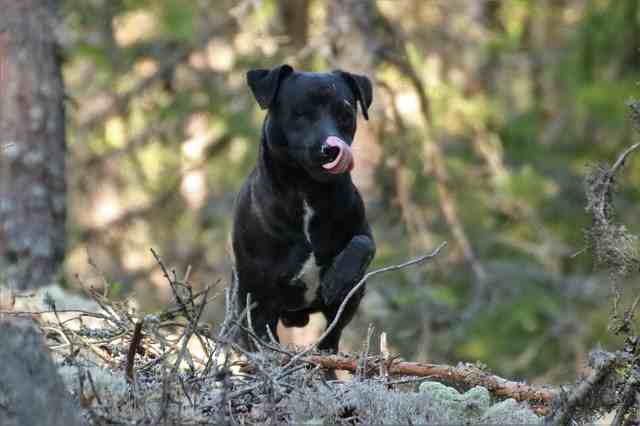Patterdale Terrier Dog Breed Profile: History, Temperament, Care
The Patterdale Terrier By Janice Jones |Published December 11, 2019
If you’re looking for high energy, hard-working terrier, the Patterdale Terrier might be just the dog for you. Bred to be a hunting dog that could run and hunt fox, badgers, and other small mammals, these dogs are incredibly energetic, loyal and independent.
They are still used as hunting dogs but now participate in a variety of canine sports. Many just live in family homes where they are family members and loyal companions.
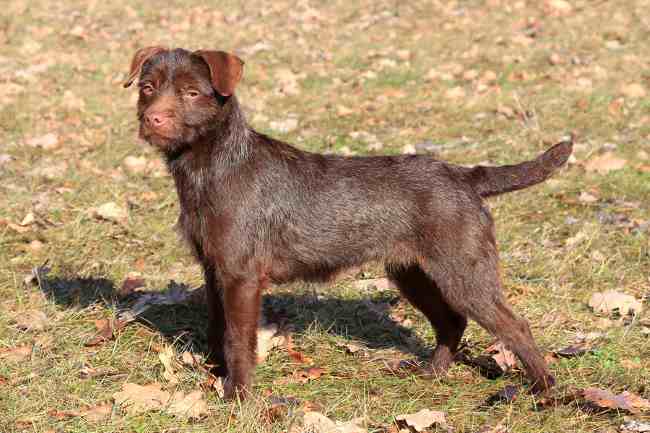
Don’t let their small size surprise you, though; their tenacity rivals any terrier breed, and their need for a great deal of exercise should not catch you off guard.
They can be challenging, and most experts recommend they would be more suited to experienced dog owners willing to take on a strong-willed dog that will need plenty of socialization and ongoing training.
If not given a job to do or kept busy with other mental and physical challenges, these dogs will create their own kind of fun, which is not likely to please the typical dog owner.
If you don’t believe just how active this breed is, take a look at these 10-week old puppies.
Quick Facts about the Patterdale Terrier
Other Names Used: Old English Terrier, Black Fell Terrier, Fell Terrier
Affiliation: UKC: Terriers
Coat Type: Two types: Smooth and Rough
Colors: black, red, liver(chocolate), gray, black and tan, or bronze.
Activity Level: Active
Good with Children: Yes
Good with other pets: Dogs, yes. Cats, maybe, Small pets, no
Average Litter Size: 6
Average Cost: $500 to 1000
| Traits | Rating |
|---|---|
| Playfulness | |
| Affection Level | |
| Friendliness Towards Strangers | |
| Good with Children | |
| Good with Other Dogs | |
| Good for First Time Owners | |
| Exercise Needed | |
| Ease of Training | |
| Watch Dog Ability | |
| Grooming Requirements | |
| Shedding | |
| Cold Tolerant | |
| Heat Tolerant |
Explanations for At a Glance Ratings
- Playfulness: Most=5 Less=1
- Affection: Most=5 Least=1
- Friendliness Towards Strangers: Most=5 Least=1
- Good with Children: Good=5 Not Good=1
- Good with Other Dogs: Good=5 Not Good=1
- Good for First Time Owners: Good=5 Not Good=1
- Amount of Exercise Required: Much=5 Minimal=1
- Ease of Training: Easy=5 Difficult=1
- Watch Dog Ability: Excellent=5 Poor=1
- Grooming Needs: Extensive=5 Minimal=1
- Shedding: Heavy Shedding=5 Minimal Shedding=1
- Cold Tolerance: Cold Well Tolerated=5 Poorly Tolerated=1
- Heat Tolerance: Heat Well Tolerated=5 Poorly Tolerated=1
Patterdale Terrier Breed History
Like most breeds, there’s a bit of mystery that accompanies any breed history because records are scarce. Many historians believe that the Patterdale Terrier originated from a shaggy coated black “Fells Terrier,” a type of small working terrier that was developed in the Fells of Northern England.
But before we go into what is known about this breed in particular, it’s well worth looking at why and how many small terriers came out of England.
Like many of today’s terriers, the Patterdale’s history can be traced back to 19th century England. Terrier breeds were created initially to hunt foxes, rabbits, and rats, on the British Isles. This particular terrier was thought to come from the Lake District in northern England.
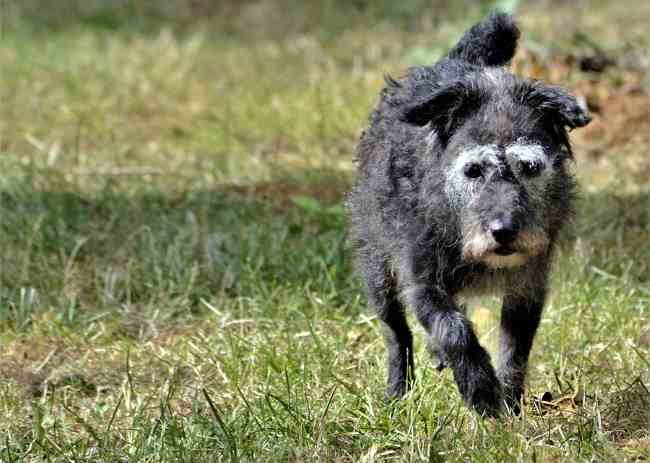
This area is covered with beautiful hills called Fells. These Fells are steep and rocky, a favorite habitat for foxes. The weather is cold and wet.
The main agricultural pursuits are sheep farming because the location does not lend itself well to other types of agriculture, such as planting crops or cattle grazing.
Fox prey on sheep, so farmers needed a way to protect their flocks, and to do so, they required little dogs that could burrow into fox dens and help eradicate these vermin.
These small dogs would also need to be able to get along with the hounds that also accompanied the hunt. Finally, they needed to be hardy, energetic and have enough stamina to run for miles over uneven terrain.
Horses were not ordinarily able to manage the rough Fells, so the huntsman, along with his dogs and assistants, would cover many miles on foot searching for foxes. Only the toughest of terriers can keep up all day, then go to ground to flush out the fox from its den.
Influential Early Breeders
Many believe that the Patterdale Terrier was developed by several breeders, Brian Nuttal, Tommy Dobson, and Joe Bowman, an early Border Terrier breeder. They wanted a terrier that would protect their flocks of sheep and other animals from predators.
Historians believe that Joe Bowman crossed a blue-black terrier with a black and tan colored Fell Terrier. Then the development of this terrier continued during the 1950s in the breeding programs of Cyril Breay and Frank Buck.
The United States did not see their first Patterdale until 1978 when they were brought to hunt boar, badgers, and raccoons. The Patterdale Terrier Club of America was formed in 1993, and the breed was accepted into the United Kennel Club in 1995.
Although still primarily a working dog, people are finding these dogs through rescue organizations and working dog breeders and welcoming them into their homes as loving, energetic companions.
In England, the Patterdale Terrier is still a working breed and is seldom shown. The breed is not recognized in England’s Kennel Club or by the American Kennel Club.
Personality of the Patterdale Terrier
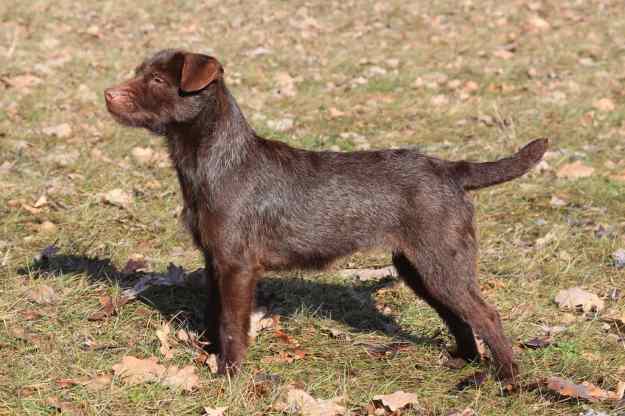
This is one tough little dog. Very playful and fun-loving, they love children, crave hunting, and hunger for any opportunity to dig or chase. Their strong-willed, determined attitude may be too much for the first time dog owner who doesn’t have much experience with training such a relentless ball of energy.
Even though they are small, they are still very much a working dog and share all the traits of terriers: Confidence, Tenacity, Independence, and Courage. They can be laid back and enjoy watching television with you, once they have gotten all of their energy needs met and is thoroughly exhausted.
The Patterdale can be vocal, but they are not considered to be yappy. They do make excellent watchdogs because of their tendency to notice any sound or movement nearby.
I feel I’m painting a negative picture of these dogs, but for energetic people or hunters, these could be a match made in heaven. They are incredibly loyal and bond quickly to their person or family.
They are affectionate and gentle around children. You couldn’t ask for a more loving breed. He does, however, need many opportunities to be challenged both physically and mentally as they are also a highly intelligent breed.
Grooming the Patterdale Terrier
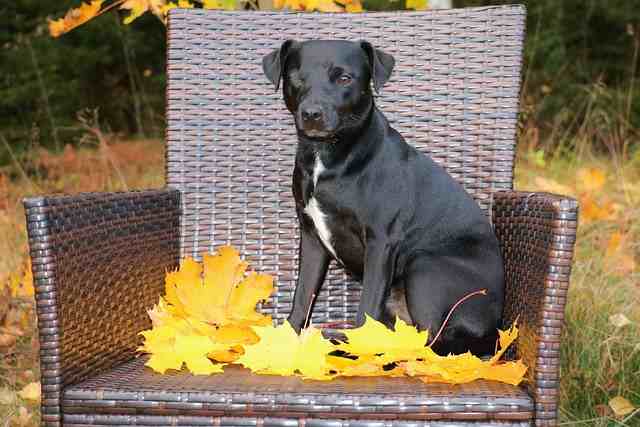
This is not a high maintenance breed, but the time you don’t spend on grooming may be devoted to training. They come in two different coat types: Rough or Broken Coat and Smooth Coat. Both types are double-coated, meaning that they have a dense undercoat and an outer coat.
Rough Coat
The Rough or Broken coat feels like long coarse hair all over the body. It is not smooth, soft, or woolly to touch. This is an ideal coat type for working terriers, and if you do a quick look at other terrier breeds, you will see that this type of hair is very common.
The rough coat is of intermediate length with longer guard hairs. They often have face furnishings that include a beard, eyebrows, and a mustache.
Great for the hunt, it is waterproof and keeps the dog warm and dry when outdoors. The hair acts as a shield, protecting the dog when burrowing or running through fields. It does not shed too much, so this type of coat may work for people with allergies.
Like other terriers, rough coats need to be stripped or plucked to remove dead hairs and make room for new growth. A proper brushing now and again will keep most of the hair in place and reduce shedding.
Most dirt can be brushed out, but these dogs will need an occasional bath especially if they have decided to roll in some unpleasant odor.
Smooth Coat
A smooth-coated Patterdale will have short thick hair that is uniform in length all over the body. There are no traces of the rough guard hairs. If lifted, the hair falls back into place naturally.
An occasional bath and brushing are all that is necessary for this coat type. Like the rough coat, the smooth coat should be thick enough to protect the dog from the elements.
Other Grooming Tasks
You will still need to clip their nails about every couple of weeks, check ears and paws, and attend to their dental health. The good news about this breed is that you should be able to do all of their grooming at home, saving money on expensive professional grooming services.
Feeding
Like all dogs, the Patterdale Terrier does very well on a high-quality diet of either commercially available food or home-made. If you plan to cook for your dog, please check with your vet first as most homemade diets require additional supplementation. Some breeders recommend a raw diet.
Since the Patterdale Terrier is very active, choose a formula for active, working dogs, but again check with your breeder or vet as many active dog formulas are designed for large breed dogs.
Choose training treats wisely and pick those that offer some nutritional value. Fruits and vegetables also make good treats.
Lifestyle
Best Suited For
These dogs will do great with active singles, couples, and
families willing to make their dog part of their daily routine. They will need several long daily walks or
playtime outdoors so the ideal person will have the time and energy to meet
their dog’s special activity needs. They
make a perfect companion for people who like to walk, hike, jog or run and will
willingly tag along to participate in other sports offered to them, including
swimming.
They are generally okay with children, but their rambunctiousness
may be too much for young toddlers and preschoolers. Other dogs in the family will not likely be a
problem, but they may not do as well with cats.
Small pocket-sized pets and little birds are likely to be seen as
prey. Their hunting instincts will kick
in, making it challenging to protect these other pets.
Exercise and Energy Needs
Your Patterdale will need daily walks or ideally jogs, and since they have energy as well as stamina, they can be great hiking companions. A large well-fenced yard is ideal for them, a place to run at top speed or play a game of fetch.
If outside a secured area, they will need to be on a leash at all times. They may be well trained, but if something such as a squirrel or chipmunk catches their eye, your Patterdale will be off for the chase and it won’t be easy to lure him back.
They will need approximately 3 daily walks of about 30 minutes in duration. Active running and playtime can be substituted for one of these walks. Do remember that historically, these dogs could run all day long during a fox hunt.
Always remember that a tired dog is a good dog. If their energy needs are not met, they can become bored and destructive.
Training
These dogs are quite intelligent but also strong-willed and independent. Training can be a challenge due to these factors, and also because he has a short attention span.
He can become distracted by anything that moves or makes a sound. A very positive approach is necessary and patience on your part will go a long way. You will need to be firm but gentle and not give in to him. Many short training sessions are more productive than a longer one.
Begin to socialize your puppy to other types of people, animals, and locations early on.
Once he has learned some basic manners and commands, you may want to move on to trick training. This is a breed that has been known to do well in that area.
Housebreaking can be difficult and should be started the day you bring your puppy home. Consistency is the key here. They bond very quickly and easily to their people and want to please.
Use that to your advantage when setting up a housebreaking schedule and routine. Praise and reward when your puppy successfully does what is expected and ignore and clean up accidents with an enzyme cleaner.
Patterdale Terrier Health Concerns
Most common purebred dog breeds have been studied extensively, and health statistics collected to determine if certain diseases are more likely to occur in a specific breed. For example, in the Breed Predispositions to Disease in Dogs and Cats 3rd Ed., there are 201 named dog breeds with reference to genetic disorders associated with the breed.
Since the Patterdale Terrier is a rare breed dog, it is not listed in the book mentioned above. Neither is it included in Canine Inherited Disorders Database (http://cidd.discoveryspace.ca/index.html) or in the Institute of Canine Biology
A study published in Plos identified 152 genetic diseases in 10,000 mixed and purebred dogs and created a database (My Breed Data) that is searchable by professionals and dog owners identified: 2 disorders associated with the Patterdale Terrier
- Degenerative Myelopathy
- Primary Lens Luxation, (PLL)
GoPetPlan.Com identifies several other potential problems in the breed.
- Cranial Cruciate Disease
- Intervertebral disc disease (IVDD)
- Hypothyroidism
- Hip dysplasia
This is generally a healthy breed but may sustain the occasional accident due to his high-energy, exuberant lifestyle.
Pros and Cons
Pros
- Loyal, intelligent, affectionate
- Good Watchdog
- Good with Children
- Generally good with other dogs
Cons
- Tendency to Dig, a big escape artist
- Strong-willed, independent
- Very strong prey drive, aggressive towards small animals
- Not trustworthy off leash
- Tendency to chase
Reference and Further Reading
Patterdale Terrier Club Of America
Does This Article Deserve Your Thumbs Up?
We always appreciate your support and encouragement. Your thumbs up means so much to us.
If you enjoyed this page, I’d love it if you’d let me know. Just click the button below. Thank you.
Sharing is Caring


